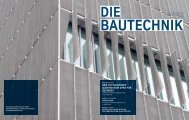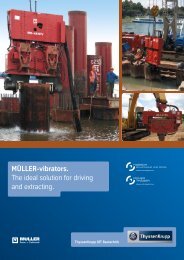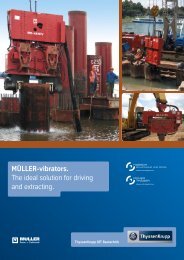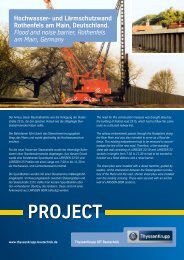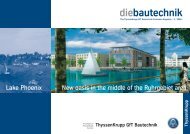- Page 2: Sheet Piling Handbook Design I
- Page 5 and 6: IV All the details contained in thi
- Page 8 and 9: Contents 1 Introduction 1 2 Sheet p
- Page 10 and 11: CONTENTS IX 5.7.7 Three-dimensional
- Page 12 and 13: Nomenclature Greek symbols α Reduc
- Page 14 and 15: NOMENCLATURE XIII σ ′ z Effectiv
- Page 16 and 17: NOMENCLATURE XV g Acceleration due
- Page 18 and 19: NOMENCLATURE XVII Indices 0 steady-
- Page 20 and 21: Chapter 1 Introduction The history
- Page 22 and 23: incomplete insight into the current
- Page 24 and 25: Chapter 2 Sheet pile walls 2.1 Sect
- Page 26 and 27: 2.1. SECTIONS AND INTERLOCKS 7 PZi
- Page 28 and 29: 2.2. PROPERTIES OF STEEL 9 Table 2.
- Page 30 and 31: 2.2. PROPERTIES OF STEEL 11 The rea
- Page 32 and 33: 2.3. DRIVING SHEET PILE WALLS 13 co
- Page 34 and 35: 2.3. DRIVING SHEET PILE WALLS 15 Fi
- Page 36 and 37: 2.3. DRIVING SHEET PILE WALLS 17 Ba
- Page 38 and 39: 2.3. DRIVING SHEET PILE WALLS 19 Ta
- Page 40 and 41: 2.3. DRIVING SHEET PILE WALLS 21 Fi
- Page 42 and 43: Chapter 3 Subsoil In order to guara
- Page 46 and 47: 3.2. LABORATORY TESTS 27 3.2 Labora
- Page 48 and 49: 3.2. LABORATORY TESTS 29 3.2.4 Unco
- Page 50 and 51: 3.2. LABORATORY TESTS 31 Figure 3.4
- Page 52 and 53: 3.3. SOIL PARAMETERS 33 • Unconso
- Page 54 and 55: Table 3.5: Characteristic values of
- Page 56 and 57: Nr. 1 2 3 4 5 6 7 8 9 10 18 Inorgan
- Page 58 and 59: Chapter 4 Groundwater If a sheet pi
- Page 60 and 61: 4.2. EXCESS HYDROSTATIC PRESSURE 41
- Page 62 and 63: 4.3. TAKING ACCOUNT OF GROUNDWATER
- Page 64 and 65: 4.3. TAKING ACCOUNT OF GROUNDWATER
- Page 66 and 67: 4.3. TAKING ACCOUNT OF GROUNDWATER
- Page 68 and 69: 4.4. HYDRAULIC GROUND FAILURE 49 Δ
- Page 70 and 71: 4.4. HYDRAULIC GROUND FAILURE 51 Δ
- Page 72 and 73: Chapter 5 Earth pressure 5.1 Genera
- Page 74 and 75: 5.2. LIMIT AND INTERMEDIATE VALUES
- Page 76 and 77: 5.2. LIMIT AND INTERMEDIATE VALUES
- Page 78 and 79: 5.2. LIMIT AND INTERMEDIATE VALUES
- Page 80 and 81: 5.3. EARTH PRESSURE DISTRIBUTION 61
- Page 82 and 83: 5.4. CALCULATING THE EARTH PRESSURE
- Page 84 and 85: 5.5. CALCULATING THE EARTH PRESSURE
- Page 86 and 87: 5.5. CALCULATING THE EARTH PRESSURE
- Page 88 and 89: 5.6. EARTH PRESSURE DUE TO UNCONFIN
- Page 90 and 91: 5.7. CONSIDERING SPECIAL BOUNDARY C
- Page 92 and 93: 5.7. CONSIDERING SPECIAL BOUNDARY C
- Page 94 and 95:
5.7. CONSIDERING SPECIAL BOUNDARY C
- Page 96 and 97:
5.8. EARTH PRESSURE REDISTRIBUTION
- Page 98 and 99:
5.9. EXAMPLES OF EARTH PRESSURE CAL
- Page 100 and 101:
5.9. EXAMPLES OF EARTH PRESSURE CAL
- Page 102 and 103:
Chapter 6 Design of sheet pile wall
- Page 104 and 105:
6.2. SAFETY CONCEPT 85 • Safety c
- Page 106 and 107:
6.3. ACTIONS AND ACTION EFFECTS 87
- Page 108 and 109:
6.5. STRUCTURAL SYSTEMS 89 Merely t
- Page 110 and 111:
6.5. STRUCTURAL SYSTEMS 91 the wall
- Page 112 and 113:
6.5. STRUCTURAL SYSTEMS 93 Figure 6
- Page 114 and 115:
6.6. STRUCTURAL CALCULATIONS 95 Fig
- Page 116 and 117:
6.6. STRUCTURAL CALCULATIONS 97 Fig
- Page 118 and 119:
6.6. STRUCTURAL CALCULATIONS 99 If
- Page 120 and 121:
6.6. STRUCTURAL CALCULATIONS 101 Th
- Page 122 and 123:
6.6. STRUCTURAL CALCULATIONS 103 Ex
- Page 124 and 125:
6.6. STRUCTURAL CALCULATIONS 105 Kr
- Page 126 and 127:
6.6. STRUCTURAL CALCULATIONS 107 Ca
- Page 128 and 129:
6.6. STRUCTURAL CALCULATIONS 109 Th
- Page 130 and 131:
6.6. STRUCTURAL CALCULATIONS 111 Fi
- Page 132 and 133:
6.6. STRUCTURAL CALCULATIONS 113 Ex
- Page 134 and 135:
6.6. STRUCTURAL CALCULATIONS 115 6.
- Page 136 and 137:
6.6. STRUCTURAL CALCULATIONS 117 Ca
- Page 138 and 139:
6.7. ANALYSES FOR THE ULTIMATE LIMI
- Page 140 and 141:
6.7. ANALYSES FOR THE ULTIMATE LIMI
- Page 142 and 143:
6.7. ANALYSES FOR THE ULTIMATE LIMI
- Page 144 and 145:
6.7. ANALYSES FOR THE ULTIMATE LIMI
- Page 146 and 147:
6.7. ANALYSES FOR THE ULTIMATE LIMI
- Page 148 and 149:
6.9. OVERALL STABILITY 129 DIN 1054
- Page 150 and 151:
6.9. OVERALL STABILITY 131 Example
- Page 152 and 153:
Chapter 7 Ground anchors 7.1 Types
- Page 154 and 155:
7.1. TYPES OF GROUND ANCHORS 135 eq
- Page 156 and 157:
7.3. DESIGN 137 • Design against
- Page 158 and 159:
7.3. DESIGN 139 Example 7.1 Design
- Page 160 and 161:
7.3. DESIGN 141 Example 7.3 Pull-ou
- Page 162 and 163:
7.3. DESIGN 143 7.3.5 Verification
- Page 164 and 165:
7.3. DESIGN 145 If Qk is not determ
- Page 166 and 167:
7.3. DESIGN 147 4. Weight of body o
- Page 168 and 169:
7.3. DESIGN 149 4. Weight of body o
- Page 170 and 171:
7.5. CONSTRUCTION DETAILS 151 Figur
- Page 172 and 173:
7.5. CONSTRUCTION DETAILS 153 Figur
- Page 174 and 175:
Chapter 8 Using FEM for the design
- Page 176 and 177:
8.2. RECOMMENDATIONS REGARDING THE
- Page 178 and 179:
8.3. EXAMPLE OF APPLICATION 159 -9.
- Page 180 and 181:
8.3. EXAMPLE OF APPLICATION 161 41
- Page 182 and 183:
8.3. EXAMPLE OF APPLICATION 163 A s
- Page 184 and 185:
8.3. EXAMPLE OF APPLICATION 165 Fig
- Page 186 and 187:
8.3. EXAMPLE OF APPLICATION 167 . .
- Page 188 and 189:
Chapter 9 Dolphins 9.1 General Dolp
- Page 190 and 191:
9.3. DETERMINING THE PASSIVE EARTH
- Page 192 and 193:
9.4. SPRING CONSTANTS 173 c = F f (
- Page 194 and 195:
Chapter 10 Choosing pile sections T
- Page 196 and 197:
Bibliography [1] Bathe, K.-J.: Fini
- Page 198 and 199:
BIBLIOGRAPHY 179 [32] Recommendatio
- Page 200 and 201:
Appendix A Section tables for preli
- Page 202 and 203:
HOESCH sections, UNION straight-web
- Page 204 and 205:
PEINE P locking bar ▲ ▲ y ▲
- Page 206 and 207:
Selection from the complete range C
- Page 208 and 209:
Appendix B Round steel tie rods 189
- Page 210 and 211:
Round steel tie rods to EAU 2004 Ti
- Page 212:
INDEX 193 loadbearing effect of ten



